If I have a recurring nightmare, it is this:
I’m sitting in a driverless car, watching through the windshield as it heads at full speed toward either another car, a wall or barrier, or a cliff — and I can do nothing to stop it. The car is experiencing the sort of glitch that frustrates us when it happens to a laptop or smartphone but can be deadly on the highway. And I can’t reboot it. There isn’t time to turn it off, get out, jump back in and turn it back on, if that’s what you’re supposed to do.
So when I watched reports out of Austin, Texas this week, I had to do so with one half-open eye, and with a racing pulse.
Austin is home to the debut of Elon Musk’s fleet of Tesla robotaxis, which began serving that city on Monday.
First, let me acknowledge that the overwhelming majority of taxi rides were incident-free. No one spends much time talking about those, which says something about human nature and the definition of news.
Second, I understand that humans make a lot of mistakes. I may be safer in a robotaxi than I would be in a traditional taxi with a driver who is inattentive, overly aggressive, inebriated or experiencing a sudden health emergency.
Safer than human drivers?
I say “may,” because a Brookings Institution study concluded, “the safety advantages of self-driving cars are aspirational but have not been proven.” Humans make dumb mistakes, but humans also write the code for self-driving cars, and they make mistakes there, too.
But those thoughts don’t help much when I watch a Youtube video, taken by a passenger, that shows a robotaxi hesitating during a left turn, then deciding instead to barrel straight ahead down the wrong side of the road to the next left-turn lane. Granted, there was no oncoming traffic, but the car appears to straddle the center stripe at one point, resulting in a horn-honk from a car out of view.
Nobody crashed. No one was hurt. But I believe some traffic rules were violated and I’m not sure who would have had to sign the ticket, if there had been one.
Perhaps more relevant in today’s world, if the incident led to road rage, with whom would the enraged driver pick a fight?
I felt similar anxiety watching a different video, on Reddit, showing a robotaxi dropping its passengers off while blocking part of an intersection. A passenger had pushed a button indicating he wanted to be dropped off before reaching the original destination. I’m guessing he imagined this would happen in a safer place.
Instead the car stopped in the intersection and the doors opened. Then the car stayed in that spot for a few moments, blocking traffic, before moving on.
Driverless accidents
Austin may be the first city to have Tesla robotaxis, but different brands have been operating several American cities, including Austin, for a while. These have not gone without incidents or deaths. Nor are they glitch-free. One man found himself endlessly circling a parking lot in Los Angeles in a Waymo cab that was supposed to be taking him to the airport.
In October 2023, a GM Cruise taxi allegedly hit a pedestrian and seriously injured her. GM later abandoned its self-driving subsidiary.
The Craft law firm in Texas recently conducted research that showed autonomous vehicles were involved in 83 fatalities as of June 17, 2024, and in 3,979 incidents from 2019 to June 2024. Brookings said computers are “notoriously brittle and malfunction in unpredictable ways.”
Here to stay
And yet, I have no doubt that self-driving cars are here to stay, barring some terrible catastrophe.
Humans lack the patience to wait for a perfectly safe autonomous model, and maybe that’s OK, to some extent. Perfection is impossible in an imperfect world, and it would be silly to let it become the enemy of the good. But the glitches in Austin this week may indicate that today’s technology isn’t always good.
We can hope that the software gets better with each mistake, and that those mistakes don’t result in injury or death. In the long run, I’m convinced the advantages of reliable driverless cars will make travel better.
Which brings me to the flip side of my recurring nightmare. It is the happy thought that my twilight years will be spent being assisted by a friendly robot into a car that delivers me safely to doctor appointments, shopping and chess games in the park without having to inconvenience anyone else.
I believe that day is coming, even if I’ll have to face it with one eye half open and a racing pulse.


